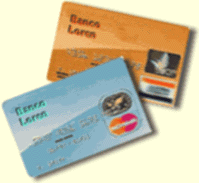| Banco Central Museum |

Credit Cards
Small plastic cards are increasingly replacing the use of bank notes and coins. Financial institutions, banks, and a growing number of shops offer their clients cards that may be used for purchasing a large number of goods and services, including virtual shops in the Internet. Cards are not real money: they just register the purchaserís willingness to pay. Eventually the bill must be paid, in either hard cash or check. Cards are, therefore, an immediate form of credit.
Credit cards appeared in the United States during the twenties. Petrol stations, hotels and companies started to offer it to their regular customers. They could fill the tank of the car and stay in a hotel without using money or check.
In 1950, the Diners Club launched the first modern credit card. It was initially accepted in twenty-seven good restaurants in the USA, and was used by important businessmen as a practical way of paying their travel, work, and leisure expenses. Made in cardboard, the card had the name of the member on one side and, on the other, a list of affiliated establishments. It was only in 1955 that Diners started to issue plastic cards.
In 1958, it was American Expressí turn to launch its card. At that time, banks realized that they were losing the market control to these institutions and, on that same year, the Bank of America introduced its BankAmericard. In 1977, the BankAmericard changed its name to Visa. In the nineties, Visa became the larger worldwide card, accepted by twelve million establishments.
Several plastic cards do not have purchasing power. They just help using and obtaining known forms of money. They are bankcards that guarantee checks, withdraw money and make payments in automatic tellers.
Other cards couple the functions of purchasing, permitting current account transactions, and guaranteeing special checks.
Commercial establishments are creating their own cards. Devised to regular clients, such cards make purchases easier and avoid the bureaucracy of opening a credit line.
In some countries, telephone cards constitute a practical way of making calls from public booths without being burdened by tokens or coins. At each call, the cost of the service is deducted from the cardís face value.
The most recent technological breakthrough in credit cards was the smart card, the intelligent plastic chip. Perfect for small purchases, they include a chip that is credited with a predetermined sum of money. As the cardholder spends, the cardís balance is being electronically withdrawn. When the balance is over, the card may be credited with a fresh amount.
Cards have multiplied. Today they are increasingly channeled to different market niches. They are the affinity cards, that support social and ecologic campaigns; cards for young university students; or business cards for the high staff of a company.
Note:Excerpt from "The Many Faces of Money", of the Central Bank Cultural Center.
 Back to the homepage Back to the homepage |